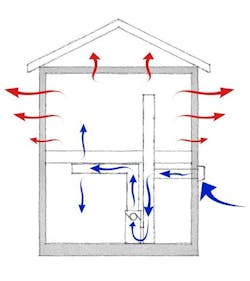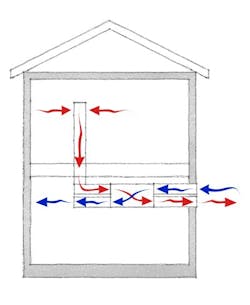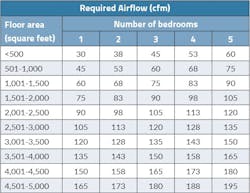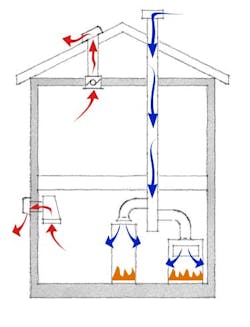Not so long ago, houses were leaky enough to provide adequate natural ventilation. In those structures, mechanical ventilation was limited to mostly kitchen and bath fans used for spot control of moisture and odors. But houses have become significantly tighter during the past 15 to 20 years, and today above-code programs, and most recently the building codes, have generally made it a requirement to provide for the intentional exchange of indoor air with fresh outdoor air at a controlled rate using fans, or what is commonly called whole-house mechanical ventilation.
In addition to providing a consistent supply of outdoor air for improved indoor air quality and occupant comfort, whole-house mechanical ventilation improves control over the amount and source of outdoor air that is brought into the home. This helps to control relative humidity and reduce moisture accumulation during the heating or temperate seasons. It also dilutes indoor contaminants, such as formaldehyde, cleaning agents, odors, and allergens, which take longer to dissipate in a tighter house. And, of course, it meets the 2012 International Residential Code (IRC) and many energy and green program requirements.
There are three types of whole-house mechanical ventilation systems: exhaust-only, supply-only, and balanced. Each system uses a combination of fans, ducting, dampers, and controls, and each system has benefits and drawbacks (see “Ventilation Checklist”).
Exhaust-Only
This system commonly uses an efficient bath fan to exhaust indoor air. This tends to depressurize the house, which causes outdoor makeup air to be drawn into the house through leaks in the building enclosure.
Pros
- Lowest installed cost and low operating cost.
Cons
- Contaminants may be drawn into the house from an attic, garage, crawlspace, or wall cavity.
- Potential to draw moist outdoor air into the wall cavity that could condense during the cooling season and cause moisture problems, particularly in warm, humid climates.
- Outdoor air may not be well-distributed.
- Could cause or contribute to backdrafting of combustion appliances.
Supply-Only
A fan draws outdoor air into the house, which tends to pressurize the house. Indoor air escapes through the building envelope and bathroom and kitchen exhaust fan ducts. Although supply-only could be a dedicated system, it is more commonly a central-fan integrated (CFI) system, in which outdoor air is ducted to the return plenum of an HVAC air handler that draws in and distributes the outdoor air.
Pros
- Minimizes contaminants entering through the building enclosure.
- Outdoor air is drawn from a single, known location for best air quality.
- For a CFI system, air is well-distributed and can be filtered and conditioned.
- Low installed cost (a CFI system may be higher in initial cost and operating costs).
Cons
- Potential to drive moist indoor air into the wall cavity that could condense and cause moisture problems during the heating season in colder climates.
- Must be designed to avoid occupant discomfort due to cold outdoor air.
Balanced
A combination of exhaust and supply methods—for example, an exhaust fan combined with a supply fan or passive inlet vents—limits house-pressure imbalances, providing approximately equal indoor exhaust and outdoor supply airflows. A balanced system may include an HRV (heat recovery ventilator), which transfers a portion of the heat between the exhaust air and the fresh air, and is generally recommended for dry, cold climates, or an ERV (energy recovery ventilator, which transfers heat and moisture, and is generally recommended for moist, warm climate. Equipped with an HRV or ERV, a balanced system provides the benefits of supply-only and exhaust-only methods, but limits their drawbacks.
Pros
- All of the benefits of exhaust- and supply-only systems, plus the option to duct an HRV or ERV independently or integrate it with the HVAC duct system.
- Energy transfer operating cost savings. (These savings are somewhat offset by fan energy—particularly when integrated with the HVAC system—and additional maintenance.)
Cons
- Highest installed cost for HRV or ERV because of the need for additional equipment and ducting.
Airflow Rate
ASHRAE Standard 62.2 is a ventilation standard for new and existing homes, and is the basis for the whole-house mechanical ventilation rates in the 2012 IECC and 2012 IRC. Minimum continuous and intermittent rates are prescribed using tables; ASHRAE 62.2-2013 prescribes a higher minimum continuous rate that can be modified based on building tightness test results.
The 2012 International Residential Code (IRC) included requirements for whole-house mechanical ventilation for the first time. When released, Chapter 11: Energy Efficiency, was identical to the residential energy-efficiency requirements in the 2012 International Energy Conservation Code (IECC) and included, among other provisions, requirements for whole-house mechanical ventilation, air leak testing, minimum fan efficiency, minimum continuous and intermittent whole-house mechanical ventilation rates, and controls with manual override.
Since then, the 2015 editions of both codes have been released. Additionally, many states have not yet adopted the most recent edition, or have partly adopted it or made modifications. Consult with your local jurisdiction for up-to-date requirements.
Airflow performance.
Measured airflows are frequently less than design values due to an overly restrictive duct system. For an efficient duct layout that will reduce airflow resistance and help ensure expected performance, follow these recommendations:
- Minimize duct lengths and number of elbows
- Account for pressure drop of all components including termination hoods
- Use manufacturer’s airflow and static pressure data; prescriptive duct sizing tables may use different
- static pressures
- Increase duct diameter if necessary
- Install in accordance with manufacturer’s instructions
Ventilation controls
Controls prevent underventilation and over-ventilation that could lead to excessive energy use (heating, cooling, and fan) or occupant discomfort. A control may be a timer, humidistat, or other duty cycling device that controls ventilation based on time, cumulative hourly run-time of the HVAC system, or severe outdoor conditions.
Ventilation Checkllist
Table 4.1a from ASHRAE 62.2-2013 is one way to determine airflow requirements, but results will be higher than those from the formula (0.03 x Floor Area) + 7.5 (No. of Bedrooms +1). For the most accurate calculations in existing homes, consult with an energy professional who will include data from blower-door testing.
For best performance of whole-house mechanical ventilation systems, follow these suggestions:
- Determine the required minimum continuous airflow rate (see Required Airflow table, right).
- Select the most appropriate type of system based on desired performance factors. (Note that exhaust-only whole-house mechanical ventilation may not be appropriate where natural draft and induced draft appliances are installed.)
- Select equipment fan size based on intermittent operation as required (ASHRAE 62.2).
- Select controls to avoid under-ventilation and over-ventilation.
- Design duct layouts to ensure that tested airflow rates will meet design requirements, using manufacturer instructions and industry standards such as Manual D (ACAA 2009).
- Inspect bath and kitchen exhaust systems for proper installation—these are the most effective ways to
- control moisture.
- Test the operation of all mechanical ventilation systems and confirm that controls are operating properly.
Backdrafting
With the potential of leading to unsafe carbon-monoxide levels, backdrafting occurs when negative house pressure is high enough to draw products of combustion from fuel-burning appliances into the house instead of being vented outdoors through a chimney or vent. Combustion appliances with potential for backdrafting include furnaces, water heaters, fireplaces, and other equipment that burns natural gas, propane, oil, kerosene, or wood. Factors that affect pressure conditions inside a house include stack effects, wind effects, HVAC, and exhaust fans.
Exhaust fans
Although Exhaust fans. Although a small (50 to 80 cfm) bath exhaust fan used for whole-house mechanical ventilation could cause backdrafting, a more likely cause is the operation of a larger-capacity exhaust fan—for example, a 300 to 1,200 cfm kitchen rangehood fan or a 150 to 400 cfm inline multi-inlet bath fan—unless make-up air is provided. Other exhaust appliances (clothes dryers, central vacuums, and conventional bath fans) operating concurrently would further increase the potential for backdrafting.
Testing
Retrofitting an existing house with energy-efficiency improvements could significantly reduce the natural air exchange rate with the outdoors, potentially creating a backdrafting hazard (see “Preventing Backdraft,” page 36). Where whole-house mechanical ventilation is now required to maintain acceptable indoor air quality, combustion safety testing can be used to identify existing issues before retrofit work begins, and to confirm the safe operation of combustion appliances after work is complete.
For example, the BPI Building Analyst Professional Standard includes a procedure to perform a depressurization test for each combustion appliance zone (CAZ). This procedure is generally performed in conjunction with testing for building tightness, carbon monoxide, and spillage and draft for natural draft and mechanical draft furnaces and water heaters. Test results may require modifications to maintain combustion safety.
Preventing Backdraft
Combustion safety and exhaust fan operation should be considered together. Generally, the tighter the house, the more likely it is that depressurization could be a problem, even when code-approved combustion air requirements are met. A worst-case depressurization test will help to determine if non-direct vent combustion appliances will backdraft.
To prevent backdrafting and other combustion safety hazards, follow these suggestions:
-
Install direct-vent combustion equipment.
-
If direct-vent equipment isn’t feasible, install induced-draft or power-vented combustion appliances.
-
Confirm that combustion appliances, including fireplaces, are
-
installed and commissioned in accordance with code and manufacturer instructions.
-
Perform worst-case depressurization testing in accordance with industry standards, such as those from the Building Performance Institute, Air Conditioning Contractors of America, or The Energy Conservatory.
Adapted with permission by Sal Alfano from “Whole-House Mechanical Ventilation,” part of the TechNotes series from Home Innovation Research Labs. The complete catalog of TechNotes is available for download at homeinnovation.com/technotes.
About the Author
Sal Alfano
Executive Editor
Sal Alfano is executive editor for Professional Remodeler. [email protected], 202.365.9070






